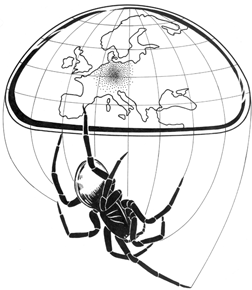Notes on the distribution of Oculicosa supermirabilis (Araneae, Lycosidae)
Notes on the distribution of Oculicosa supermirabilis (Araneae, Lycosidae)
burrowing wolf-spiders; Central Asia; distributional pattern; new records
Abstract
The distribution of the poorly known Central Asian wolf-spider Oculicosa supermirabilis Zyuzin, 1993 is clarified, discussed and mapped on the basis of both original and literature-derived data. The species is currently known from the Turan Lowland between the 41st and 43rd degrees of latitude north; its distribution coincides with that of the grey-brown desert soil and lies within the geobotanical sub-zone of southern deserts. Both sexes are also illustrated and diagnosed.
Cheiridium tetrophthalmum Daday, a new synonym of Larca lata (Hansen) (Pseudoscorpiones, Larcidae)
Cheiridium tetrophthalmum Daday, a new synonym of Larca lata (Hansen) (Pseudoscorpiones, Larcidae)
Faunistics; Geogarypus minor; Hungary
Abstract
Cheiridium tetrophthalmum Daday, 1889 is removed from the synonymy of Geogarypus minor (L. Koch, 1873), and treated as a junior synonym of Larca lata (Hansen, 1884). The distribution of Larca lata and Geogarypus minor is documented, and L. lata is recorded from Hungary for the first time.
araneae: Spinnen Europas – Spiders of Europe: www.araneae.unibe.ch
araneae: Spinnen Europas – Spiders of Europe: www.araneae.unibe.ch
url information
Abstract
url information
Worldwide catalogues and species numbers of the arachnid orders (Arachnida)
Weltweite Kataloge und Artenzahlen der Spinnentierordnungen (Arachnida)
Araneae; Opiliones; Pseudoscorpiones; Scorpiones; Solifugae; Schizomida; Amblypygi; Uropygi; Palpigradi; Ricinulei
Abstract
Worldwide catalogues and species numbers of the arachnid orders (Arachnida)
Chthonius hungaricus and Larca lata new to the fauna of Slovakia (Pseudoscorpiones: Chthoniidae, Larcidae)
Chthonius hungaricus and Larca lata new to the fauna of Slovakia (Pseudoscorpiones: Chthoniidae, Larcidae)
Central Europe; faunistics; new records; taxonomy
Abstract
Chthonius (Chthonius) hungaricus Mahnert, 1980 and Larca lata (Hansen, 1884) were recorded for the first time from Slovakia. The finding of C. hungaricus in Slovakia is the second known record since its description and the finding of L. lata is the first record of the family of Larcidae in Slovakia. The descriptions of the species offer an update on the variability of morphologic and morphometric characters. Indications about the habitats of C. hungaricus are also given for the first time.
Spinnen (Araneae) in Küstendünenheiden der Insel Hiddensee (Mecklenburg-Vorpommern)
Spiders (Araneae) from coastal heathland on the Isle of Hiddensee (Mecklenburg-Western Pomerania)
Baltic Sea; faunistics; Flora-Fauna-Habitat directive; grey dune; heathland
Abstract
The present paper provides the first checklist of the spiders from coastal heathland on the Baltic Sea island of Hiddensee, Germany. A total of 171 species could be recovered by pitfall trapping in 2008 and 2009. The species inventory comprises several typical dune and heathland species. Ten species (Altella lucida, Centromerus capucinus, Dictyna latens, Drassodes cupreus, Hypsocephalus pusillus, Hypsosinga sanguinea, Micaria lenzi, Micrargus apertus, Philodromus histrio, Walckenaeria capito) are new to the arachnofauna of Mecklenburg-Western Pomerania.
Notes on the biology of the unidentified invasive harvestman Leiobunum sp. (Arachnida: Opiliones)
Notes on the biology of the unidentified invasive harvestman Leiobunum sp. (Arachnida: Opiliones)
egg deposition; feeding behaviour; food; male-male fights; mating behaviour; nuptial feeding
Abstract
Since about the year 2000 an unidentified, introduced harvestman of the genus Leiobunum has been rapidly invading Europe. The published records are from the Netherlands, Germany, Austria and Switzerland. A population of Leiobunum sp. in the Netherlands was studied frequently during the day and night. Its life cycle, hunting strategy, diet and accompanying harvestman species were recorded, and mating, male-male fights and ovipositing behaviour studied, as well as the spider species preying on this Leiobunum species. Food items were collected, indicating that its food consists of a wide range of live as well as dead invertebrates including spent spider prey scavenged for at ground level. Vegetable matter like berries, as well as bird droppings were also consumed. The mating strategy is very complex. A male guards an egg depositing female and he defends her against other advancing males, resulting in male-male fights. The guarding male frequently mates. Also courtship behaviour has been observed, including nuptial feeding with a fluid, probably originating from the accessory penal glands and delivered by the male into the female’s stomotheca via sacs located on the distal part of the penis truncus. Eggs are deposited in holes and crevices of walls.
Wie viele Arten von Milbenkankern (Opiliones, Cyphophthalmi) gibt es in Österreich?
How many species of mite-harvestmen (Opiliones, Cyphophthalmi) are there in Austria?
cryptic diversity; Cyphophthalmus; harvestmen; Siro; Sironidae
Abstract
For the last 60 years, the mite-harvestman Cyphophthalmus duricorius Joseph, 1868, a soil-dwelling sironid, has been considered to be the only representative of the opilionid suborder Cyphophthalmi in Austria. However, novel data from recent collections confirm the presence of at least two further Austrian cyphophthalmid species. (1) Siro cf. crassus Novak & Giribet, 2006 occurs in at least one location in SW Styria near the Slovenian border and hence represents a member of a second genus of Austrian sironids. (2) A further morphologically distinct sironid (“Sironidae gen. et sp. nov.?”) – so far undescribed and systematically not placed in detail – was collected in the borderland between Styria and Carinthia. All three species can be found in a small area of a few square-kilometers; although no syntopic occurrence was recorded.
Marco Isaia, Mauro Paschetta, Enrico Lana, Paolo Pantini, Axel L. Schönhofer, Erhard Christian & Guido Bandino (2011): Aracnidi sotterranei delle Alpi Occidentali italiane/Subterranean Arachnids of the Western Italian Alps (Arachnida: Araneae, Opiliones,
Marco Isaia, Mauro Paschetta, Enrico Lana, Paolo Pantini, Axel L. Schönhofer, Erhard Christian & Guido Bandino (2011): Aracnidi sotterranei delle Alpi Occidentali italiane/Subterranean Arachnids of the Western Italian Alps (Arachnida: Araneae, Opiliones,
book review
Abstract
book review: Marco Isaia, Mauro Paschetta, Enrico Lana, Paolo Pantini, Axel L. Schönhofer, Erhard Christian & Guido Bandino (2011): Aracnidi sotterranei delle Alpi Occidentali italiane/Subterranean Arachnids of the Western Italian Alps (Arachnida: Araneae, Opiliones, Palpigradi, Pseudoscorpiones)
25th European Congress of Arachnology, Alexandroupoli, Greece: preface
25th European Congress of Arachnology, Alexandroupoli, Greece: preface
Preface
Abstract
Preface: Chatzaki, M., T. Blick & O.-D. Finch (Eds) (2011): European Arachnology 2009. Proceedings of the 25th European Congress of Arachnology, Alexandroupoli, 16–21 August 2009.


